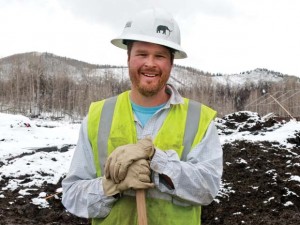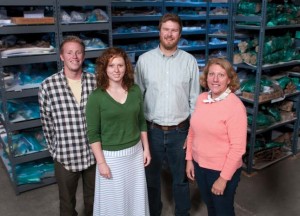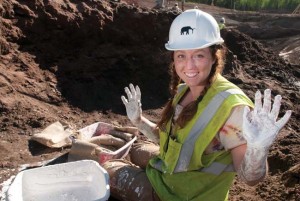
Ian Miller ’99 helped direct the excavation of thousands of plant and animal fossils from the historic discovery near Snowmass, Colo. © Denver Museum of Nature & Science
It’s an incredible view of the Rocky Mountains 100,000 years ago,” said Gussie Maccracken ’11.
“It’s unprecedented,” said Ian Miller ’99. “This is giving us a crystal clear window into Colorado’s recent past. It can tell us about climate, fire frequency, drought, and pine beetles,” said Miller, discussing what scientists are learning now from the significant fossil excavation Miller co-directed in June 2011 near Snowmass, Colo. “We’ve never seen anything like this in the high Rockies before,” he said.
Miller is curator of paleobotany and director of earth and space sciences at the Denver Museum of Nature & Science (DMNS.) Maccracken and Adam Freierman ’12 were two of nine nationally selected student interns at the Snowmastodon Project dig. Maccracken now works as a fossil lab assistant at the museum, focusing mostly on preparing and protecting fragile specimens from the site.

Adam Freierman ’12, Gussie Maccracken ’11, Ian Miller ’99, and Saxon Sharpe ’76 were part of the Snowmastodon Project science team reunited for a conference in Colorado this summer. They were photographed at the Denver Museum of Nature & Science with some of the thousands of specimens the team is now studying. © Denver Museum of Nature & Science
A fourth CC grad, Saxon Sharpe ’76, associate research professor emerita with the Desert Research Institute in Reno, Nev., is also involved in the project. The Snowmastodon Project is significant for the number, type, and condition of the fossils found, as well as being one of the largest excavations ever conducted over such a short time span.
The seven-week dig brought together 45 scientists from 18 institutions, plus 10 students and almost 250 volunteers, who shoveled some 8,000 tons of dirt to carefully extract about 6,000 large animal bones and thousands more smaller ones that are still revealing their secrets.
“It was exciting — like kids in a candy store,” said Miller about the experience of discovering hundreds of “exquisitely preserved” fossils every day. A bulldozer driver actually made the first find, uncovering mammoth bones while working to expand a reservoir near Snowmass Village in October 2010. Recognizing what they had stumbled upon, the work crew called the museum to handle the sensitive cache.
Once the dig was underway about six months later, the Snowmastodon team uncovered a host of Ice Age animals, including many not previously found fossilized in Colorado. They unearthed a single-site record of more than 50 mastodons, also notable since a total of only three had ever been found in the state before. The discovery list includes more than 125 petrified logs, hundreds of macro and micro plant samples, more than 30 species of small animals, as well as large animals such as mammoths, huge bison, camels, and giant ground sloths.
“The big guys are exciting, but the really small critters can’t move around, so we can get a sense of the environment by looking at them,” said Sharpe. She was one of many specialists called to the Snowmastodon site, in her case to look at mollusks in the various sediment layers. “Aquatic mollusks would be in the pond and terrestrial ones near the pond, so by looking at which type of mollusk is where, we can find the dry and wet times,” she said about her piece of the puzzle. The international research team is now trying to determine details about life and climate during the approximately 90,000-year time span documented at the site.
“Being there, you could imagine mastodons walking on the edge of the lake,” said Freierman, who graduated with his geology degree the year after working at the dig. He now works on botany projects with the Bureau of Land Management in Vernal, Utah, and thinks he will go to graduate school in the natural sciences, possibly paleontology.
“You’d bring out a bone and realize how long it’s been there and that no one else has seen it before. Something about that catches my imagination,” Freierman said. He still volunteers on digs with Miller and credits Miller with giving him inspiration and opportunities.
“There are so many people connected with CC — faculty, alumni, other students — doing really cool things and they try to get others involved,” said Freierman, noting that he met Miller during a Wyoming field camp through the CC geology department during the summer after his sophomore year. Freierman did his senior thesis project with Miller through the museum.

Gussie Maccracken ’11 made field jackets of burlap and wet plaster to help protect fragile specimens for transport from the Snowmastodon fossil site. © Denver Museum of Nature & Science
It’s a similar story for Maccracken and even for Miller himself. “I got a foot in the door because of my CC connections,” said Maccracken. A biology major, she was hired by the CC geology department to work on a dig the summer after her sophomore year. The next summer, she did an internship at the DMNS, going on other digs which she said sealed her “passion for paleontology.” Miller also was her senior thesis advisor and she said getting to work on the Snowmastodon Project “was one of the best experiences of my life.”
“It was so much fun, such an adventure. We were hot, exhausted, working long hours every day in all kinds of weather, but it was incredible being part of a little community focused on one goal,” said Maccracken. “We got used to knowing when we had hit a bone with our shovel. When you find one, you get on your hands and knees, brush dirt away, and then use a bamboo pick to remove harder dirt or mud,” she explained. Maccracken hopes to get a Ph.D. in some aspect of paleontology and is enjoying the opportunity to work and learn more in this discipline right now.
“It’s wonderful to teach the next generation of scientists,” said Miller about his efforts to encourage student involvement at the museum. “CC students are great lateral thinkers, they generally love being outdoors and the Block Plan lends itself to this sort of project,” he said about the fit between CC and the DMNS.
It’s actually the exact way he got his start. “The opportunities given me by CC and the museum my junior and senior years, gave me the opportunity for my career,” said Miller who worked at the DMNS while he was a student and used a CC Venture Grant to fund independent paleontology research that was not only his undergraduate senior thesis project, but also turned out to be the basis for his dissertation work at Yale University. He received his Ph.D. in geology and geophysics from Yale in 2007.
Miller believes the CC Block Plan helped him and helps current students get ready to do the research and writing work important in many science careers. “These intensive projects can’t be done while you are doing 10 other things,” said Miller.
Finding four CC alumni among the individuals selected to work on the Snowmastodon Project “speaks to the strength of the college,” said Sharpe. “It’s nice to see the school turning out such good scientists,” she said.
Earlier this year, both National Geographic magazine and the PBS NOVA program featured the Snowmastodon Project. The DMNS also released a book “Digging Snowmastodon: Discovering an Ice Age World in the Colorado Rockies” which includes some of Miller’s personal accounts of the dig and the science underway to report the findings. More information can be found at: 2cc.co/ccmastodon